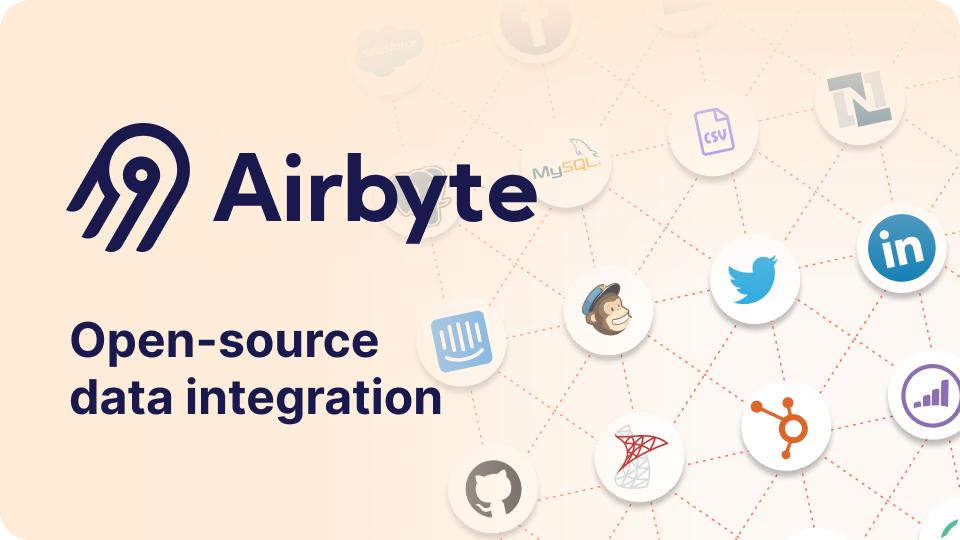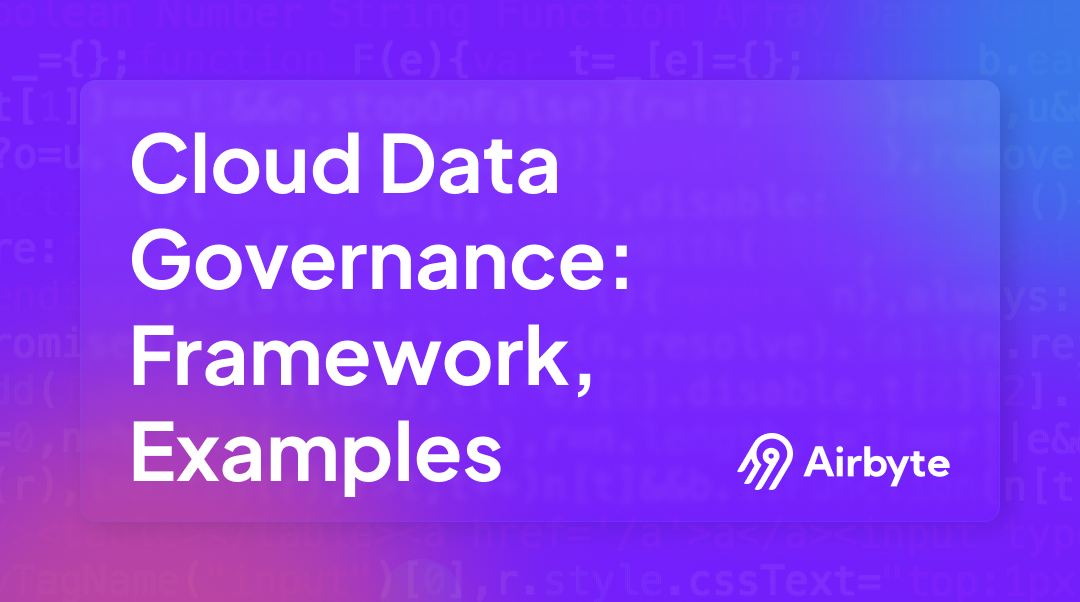What is Cloud Data Governance: Framework & Examples
Summarize this article with:
✨ AI Generated Summary
Cloud data governance establishes policies, processes, and tools to ensure data in the cloud is secure, compliant, and high-quality, enabling effective data management across multiple platforms. Key benefits include enhanced security, improved data quality, regulatory compliance, innovation, and cost optimization. Tools like Airbyte streamline data integration and automation, supporting continuous monitoring and governance maturity for sustainable business growth.
Cloud computing has completely transformed how organizations store, access, and use data.Its scalability, flexibility, and cost-effectiveness make it indispensable for modern businesses. But as data grows across multiple cloud platforms, managing security, compliance, quality, and accessibility becomes increasingly complex.
Let’s examine the details of cloud data governance, how it works, the associated benefits, and some examples to understand it better.
What is Cloud Data Governance?
Cloud data governance is essentially a set of policies, processes, and technologies that ensure your data in the cloud is secure, compliant, and used effectively. It comprises rules and tools to manage your organization’s data library.
Cloud data governance allows you to govern data access, retention, and protection. This is crucial for maintaining data quality, minimizing risks, and maximizing the value of your data in the cloud.
How Does a Cloud Data Governance Framework Help?
A cloud data governance framework provides a structured approach to managing data within a cloud environment. It serves as a blueprint, outlining the rules, processes, technologies, and roles necessary to ensure that data is handled securely, efficiently, and in compliance with regulations.
At its core, a cloud data governance framework establishes clear policies that govern how data should be classified, stored, accessed, used, and shared. Adhering to these policies can create a foundation for consistent and responsible data management practices across all your cloud environments.
Benefits of Cloud Data Governance
Cloud data governance offers several benefits, each enhancing the overall effectiveness of an organization's data strategy.
1. Enhanced Data Security
Cloud data governance protects against data breaches, unauthorized access, and potential data loss. It protects sensitive information by implementing encryption, access controls, regular audits, and disaster recovery plans. This approach ensures data integrity, enhancing your organization's reputation and customer trust.
2. Improved Data Quality
A well-defined governance framework emphasizes data accuracy, consistency, and completeness. It empowers you to implement data validation, cleansing, and standardization processes to ensure that the information used for decision-making is reliable and error-free. This leads to more informed decisions, better business outcomes, and reduced risks associated with inaccurate data.
3. Regulatory Compliance
Cloud data governance helps you manage the complexities of data protection laws such as GDPR, HIPAA, and CCPA. By adhering to these regulations, you not only avoid severe fines and legal repercussions but also build trust with customers and partners who value your commitment to data privacy.
4. Innovation and Growth
A well-structured data environment enables you to gain valuable insights, identify emerging trends, and make data-driven decisions that drive growth. This adaptability allows you to respond quickly to market changes and customer needs, fostering a culture of innovation and staying ahead of the competition.
5. Cost Optimization
Cloud governance transforms data management from a manual, error-prone, and expensive approach to an automated, efficient, and proactive one. This shift reduces operational costs by automating routine tasks and reducing errors while enhancing overall data handling efficiency, making it a good investment. Cloud governance transforms data management from a manual, error-prone, and expensive approach to an automated, efficient, and proactive one, especially when paired with a multi-cloud finops platform that provides real-time visibility and cost control across cloud environments.
Key Components of a Cloud Data Governance Framework

A successful cloud data governance strategy rests upon several fundamental pillars. These key components work together to create a comprehensive framework that governs how data is managed, protected, and utilized within the cloud environment.
Some of these key components are:
1. Data Quality Management
Quality management ensures accurate, consistent, and complete data across an organization. It incorporates processes like data validation, cleansing, and regular auditing to maintain high-quality data standards. Effective data quality management enables reliable decision-making and enhances operational efficiency.
2. Data Processes
Well-defined processes ensure data consistency and quality. These processes standardize data ingestion, cleaning, transformation, and utilization within acceptable boundaries. Continuous monitoring is important to track data usage, identify anomalies, and maintain high standards.
3. Data Tools
The right tools are essential for effective governance. Some common data tools include:
- Data quality tools that automate accuracy checks and cloud security solutions to protect data against threats.
- Data catalog tools that provide a centralized inventory of all data assets.
- Data lineage tools that track the data's lifecycle and aid in troubleshooting and compliance.
4. People and Responsibilities
Data owners, often business leaders, are accountable for data assets, ensuring their proper use and alignment with organizational values. Data stewards and technical experts manage daily data tasks, ensuring accuracy, integrity, and security.
How Cloud Data Governance Works?
Cloud data governance is an ongoing process that ensures your data is secure, reliable, and used effectively. Here’s a breakdown of the key steps involved in cloud data governance:
Step 1: Establish Policies & Accountability
Define policies for:
- Data classification & retention
- Access control & compliance
- Security standards
Assign data stewards and owners who enforce these policies.
Step 2: Select the Right Tools
Use technologies to automate compliance and visibility:
- Profiling & cleansing: detect and fix data issues
- Encryption & IAM: secure access
- Monitoring tools: Datadog, OpenTelemetry for pipeline observability
Step 3: Define Data Lifecycle Processes
Set up lifecycle rules for:
- ingestion → transformation → archival → deletion
- Incident response and change management
Step 4: Continuous Monitoring & Improvement
Track KPIs like:
- Data quality score
- Access violations
- Policy adherence rate
Refine processes regularly to strengthen governance maturity.
Key Aspects of Cloud Data Governance
Cloud data governance brings structure and clarity to how your organization handles data in the cloud. It combines people, processes, and tools to make data secure, compliant, and useful.
1. Security & Access Control
Only authorized users should have access to the right data. Governance ensures this through role-based permissions, encryption, and monitoring — reducing the risk of data breaches or misuse.
2. Data Quality
Accurate and consistent data is the backbone of good decision-making. Governance helps maintain reliability by defining validation, cleansing, and monitoring standards across all cloud platforms.
3. Compliance & Risk Management
Regulations like GDPR, HIPAA, and CCPA make compliance a must. Governance frameworks help apply the right policies — from data classification to retention — and reduce the risk of non-compliance.
4. Data Lifecycle Management
Data goes through stages: creation, use, storage, and deletion. Governance ensures each stage follows clear policies so your data remains organized, compliant, and cost-efficient.
5. Metadata & Automation
Metadata gives visibility into where data comes from and how it’s used, while automation helps scale governance tasks like classification and policy enforcement. Together, they make managing cloud data easier and more efficient.
Examples of Cloud Data Governance
Cloud data governance involves strategies employed by various organizations to manage and secure their data. Let's explore some specific use cases:
Netflix
Netflix manages massive volumes of customer data, which it uses for personalization while upholding privacy and complying with regulations like GDPR. Partnering with Amazon Web Services (AWS), Netflix leverages AWS EC2 and uses its scalable virtual machines to run its streaming applications securely, and AWS S3 for easy data access and management.
It also employs AWS Global Accelerator to improve application performance by up to 60% and provides security using the AWS Global Network. The global accelerator also helps protect Netflix from Distributed Denial-of-Service (DDoS) attacks closer to the source.
Standard Bank Group
The Standard Bank Group is a leading financial services provider and utilizes IBM data governance to secure its databases and transactions. The organization uses IBM Cloud Pak for Data and IBM Watson Knowledge Catalog solutions to evolve and develop strong, resilient data governance capabilities.
Healthcare Sector
Healthcare industry deals with many confidential research documents and patient records that contain sensitive information. This makes it necessary for them to store their data in a secure environment that is governed with strict access controls, data lineage tracking, data anonymization, and version control capabilities. Some of the prominent tools include Collibra, Ataccama, Informatica, and Atlan.
Integrate Airbyte to Streamline Cloud Data Governance Strategies
Building a robust cloud data governance framework is essential for maintaining data quality, ensuring compliance, and maximizing the value of your data repository. However, achieving data governance strategies can be obstructed by challenges related to data integration, quality, and management.
Fragmented data silos, inconsistent formats, and inaccurate data can make it difficult to unify your data effectively, which is where Airbyte can play a significant role in strengthening your data integration needs.
Airbyte simplifies your data integration journey by automating data movement from 350+ pre-built connectors, including popular sources (applications, databases), to your centralized data repository. This will allow you to create a unified view of your organizational data for better data governance.

Here's how Airbyte streamlines your cloud data governance strategy:
- Extending Existing Connectors: The Connector Development Kit (CDK) allows you to develop custom connectors to meet your specific needs within 30 minutes.
- Streamlined Data Ingestion with PyAirbyte: With PyAirbyte, you can efficiently extract data from numerous Airbyte supported sources and store it into centralized systems. It ensures easy configuration of data sources and adaptable management of data flows.
- Data Monitoring and Validation: Airbyte offers various features that let you track the performance of your data pipelines and validate data accuracy. It enables you to integrate with monitoring tools like Datadog and OpenTelemetry to address potential bottlenecks and keep pipelines running smoothly.
- Robust Security: It prioritizes the security and protection of your sensitive data by following industry-standard practices. Airbyte implements encryption methods to safeguard data both in transit and at rest. Additionally, it incorporates authentication mechanisms and robust access controls to confirm that only authorized individuals can utilize the data.
Integrating Airbyte into your cloud data governance framework enables the automation of governance processes, maintenance of data quality, and assurance of security and privacy for your valuable data assets.
Conclusion
Cloud data governance is a strategic investment that provides a structured framework for managing data in the cloud, ensuring its security, quality, compliance, and value to the organization. Establishing clear policies, processes, and roles ensures consistent data management, reduces risks, and maximizes data asset potential.
Leveraging the right tools like Airbyte can further enhance data governance efforts. Such tools can provide the necessary visibility, control, and automation to ensure data is managed efficiently.
By embracing cloud data governance, you can unlock the full potential of your data, drive informed decision-making, and achieve sustainable growth in today’s digital age.
FAQs
Why is cloud governance essential to successful cloud management?
Cloud governance is essential for successful cloud management because it provides a structured framework for managing costs, ensuring security, and maintaining compliance in the dynamic cloud environment. You can utilize cloud resources while mitigating risks and maximizing benefits by establishing clear policies, processes, and controls.
What is the core of data governance?
The core of data governance involves establishing and enforcing policies, processes, and responsibilities to ensure data is used responsibly, accurately, and securely throughout its lifecycle. This involves defining data ownership, access rights, quality standards, and compliance with relevant regulations.

